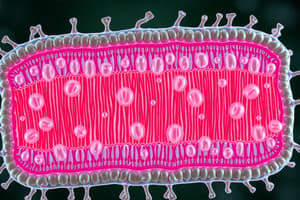Podcast
Questions and Answers
What is the size difference between procaryotic cells and eucaryotic cells?
What is the size difference between procaryotic cells and eucaryotic cells?
- Procaryotic cells are the same size as eucaryotic cells
- Procaryotic cells are 10 times larger than eucaryotic cells
- Procaryotic cells are 5 times smaller than eucaryotic cells
- Procaryotic cells are 10 times smaller than eucaryotic cells (correct)
How do procaryotic cells reproduce?
How do procaryotic cells reproduce?
- By conjugation
- By binary fission (correct)
- By meiosis
- By mitosis
Which of the following is NOT filled with internal membranes in procaryotic cells?
Which of the following is NOT filled with internal membranes in procaryotic cells?
- Chromosomes (correct)
- Ribosomes
- Cytoplasm
- Particles
What are the main components surrounding the cytoplasm of procaryotic cells?
What are the main components surrounding the cytoplasm of procaryotic cells?
What is the function of the cell membrane in procaryotic cells?
What is the function of the cell membrane in procaryotic cells?
Which type of cells lack internal membranes like chromatin and nucleus?
Which type of cells lack internal membranes like chromatin and nucleus?
What is the main characteristic that distinguishes eucaryotic cells from procaryotic cells?
What is the main characteristic that distinguishes eucaryotic cells from procaryotic cells?
Which process involves the division of a cell into two identical daughter cells?
Which process involves the division of a cell into two identical daughter cells?
What is a key feature of cell membranes that allows only certain substances to pass through them?
What is a key feature of cell membranes that allows only certain substances to pass through them?
Which of the following is a common misconception about procaryotic cell structure?
Which of the following is a common misconception about procaryotic cell structure?
What is the term for cells that do not have a 'true' nucleus and possess simpler structures?
What is the term for cells that do not have a 'true' nucleus and possess simpler structures?
Which type of cells possess a complex system of membranes and membrane-bound organelles?
Which type of cells possess a complex system of membranes and membrane-bound organelles?
What is the main function of the cell membrane in eucaryotic cells?
What is the main function of the cell membrane in eucaryotic cells?
Which component is considered the 'command center' of the cell?
Which component is considered the 'command center' of the cell?
What is the characteristic feature of eucaryotic chromosomes?
What is the characteristic feature of eucaryotic chromosomes?
How many chromosomes do human diploid cells have?
How many chromosomes do human diploid cells have?
Which term refers to an organism's complete collection of genes?
Which term refers to an organism's complete collection of genes?
Which component separates the cell from the outside environment?
Which component separates the cell from the outside environment?
Flashcards are hidden until you start studying
Study Notes
Eucaryotic Cell Structure
- The cell membrane is composed of proteins and phospholipids, separating the cell from the outside and regulating the passage of nutrients and waste with selective permeability.
The Eucaryotic Nucleus
- The nucleus is the "command center" of the cell, controlling all cellular functions.
- It consists of three components: nucleoplasm (gelatinous matrix), chromosomes, and a nuclear membrane with holes.
- Chromosomes are embedded in the nucleoplasm, consisting of linear DNA molecules and proteins (histones).
- Genes are located along chromosomes, with each gene containing information to produce one or more gene products (usually proteins).
- The human genome consists of between 20,000 and 30,000 genes.
Eucaryotic Nucleus, cont.
- Although most genes code for proteins, some code for two types of ribonucleic acid (RNA): ribosomal RNA (rRNA) and transfer RNA (tRNA).
- The number and composition of chromosomes and the number of genes on each chromosome are characteristic of a particular species of organism.
- Human diploid cells have 46 chromosomes (23 pairs).
Cell Structure and Taxonomy
- The cell is the fundamental unit of any living organism, exhibiting the basic characteristics of life (obtaining nutrients, metabolism, mutation).
- Cytology is the study of the structure and function of the cell.
- There are two categories of cells: eucaryotic and procaryotic.
Acellular and Cellular Microbes
- Eucaryotic cells contain a "true" nucleus, whereas procaryotic cells do not.
- Eucaryotic cells possess a complex system of membranes and membrane-bound organelles, whereas procaryotic cells do not.
- Both eucaryotic and procaryotic cells possess a cell membrane with selective permeability.
Procaryotic Cell Structure
- Procaryotic cells are about 10 times smaller than eucaryotic cells.
- Procaryotic cells are simple compared to eucaryotic cells and reproduce by binary fission.
- All bacteria are procaryotes, as are archaea.
- The cytoplasm of procaryotic cells is not filled with internal membranes.
Procaryotic Cell
- The cytoplasm of procaryotic cells is surrounded by a cell membrane, a cell wall (usually), and sometimes a capsule or slime layer.
- The cell membrane is similar in structure and function to the eucaryotic cell membrane, being selectively permeable and flexible.
Studying That Suits You
Use AI to generate personalized quizzes and flashcards to suit your learning preferences.




